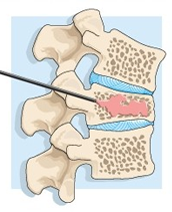
Kyphoplasty /
Vertebroplasty
Kyphoplasty/vertebroplasty are techniques used for treating vertebral compression fractures, small breaks in the thick mass of bone that makes up the front part of the vertebra (called the vertebral body). Vertebral body fractures lead to the collapse or compression of a vertebra, causing the spine to shorten and curve forward. This can result in pain and a kyphotic (hunched-over) deformity. Thinning of bones, or osteoporosis, is the main cause of vertebral compression fractures. Pathologic fractures related to spinal tumors may also be a cause of fractures.
During the procedures, the patient will lie on his or her stomach. The doctor will then insert a hollow needle, called a trocar, through the skin and into the vertebra. A type of X-ray, called fluoroscopy, is used to guide the trocar into proper position.
Once the trocar is in place, either cement (vertebroplasty) or an inflatable balloon-like device (kyphoplasty) are inserted into the vertebra through the trocar. During a kyphoplasty, as the balloon is inflated, it opens up a space to be filled with bone cement.
In addition to stabilizing the vertebra and relieving pain, kyphoplasty/vertebroplasty attempt to restore the height of the vertebra, thereby straightening out the spinal curve.
Who is a candidate for these procedures?
Kyphoplasty/vertebroplasty are generally reserved for people with painful progressive back pain secondary to osteoporotic or pathologic vertebral compression fractures. Candidates for these procedures often experience significant decreases in mobility and function as a result of the fractures.
To be a candidate for a kyphoplasty/vertebroplasty, a patient’s pain must correlate to the vertebral fracture, and must not be due to other problems, such as disk herniation, arthritis, or stenosis. Imaging tests – such as spinal X-rays, bone scans, and computed tomography (CT) or magnetic resonance imaging (MRI) scans – might be ordered to confirm the presence of a vertebral fracture.
What type of anesthesia is used during a kyphoplasty/vertebroplasty? Kyphoplasty/vertebroplasty are considered minimally invasive procedures that are most often performed using general anesthesia, depending on the doctor and the needs of the patient. In most cases, this procedure is performed as an overnight stay, although many patients do go home the same afternoon.
Is kyphoplasty painful?
Patients may feel sore in the area where the trocar was inserted. However, this should resolve within a couple of days. Applying ice to the area can help relieve any soreness.
How effective is kyphoplasty/vertebroplasty?
Kyphoplasty/vertebroplasty usually provide pain relief and improved mobility within 48 hours of the procedures. In some cases, however, patients feel pain relief immediately. The majority of patients are satisfied with the results, with many returning to all their usual activities they were performing before the vertebral fracture occurred.



